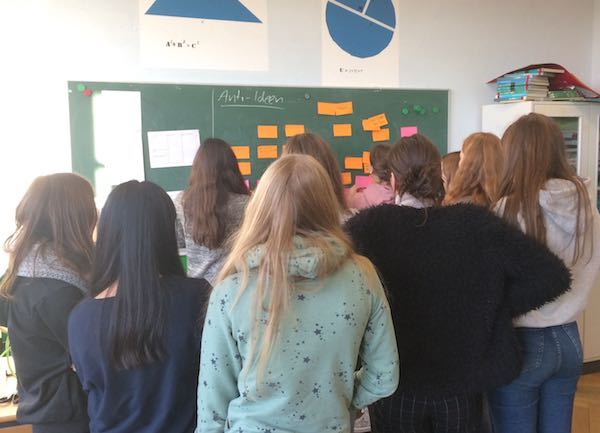November 14, 2018
Moinschool started in September to integrate more female students into our community
We started our project moinschool in Hamburg at the event TINCON Hamburg where we had a workshop with aluminum boats which illustrated how computer science is about problem solving. To take that a step further, we continued with design thinking session last week back at the school. Design thinking sounds like one of the latest buzz-words, but in reality it is nothing more than problem solving, in a less tranditional sense. The idea of using congnitive, strategic and practical methods to design concepts dates back to the1960s.
Away from strict hierarchical management to empowered, self managed teams
Generally design thinking gained a lot of traction recently due to transformation of many companies away from strict hierarchical management to empowered, self managed teams. These teams often use Design Thinking as a way to create product ideas and push innovation forward. Key feature that sets Design Thinking apart is the multidisciplinaty team structure. In this way, people use their collective intelligence to go beyong their own professional boundaries, away from individualistic thinking, and toward a common creation. In a design thinking process, a group is presented with a problem, or a mission, or a goal – and works from bottom up, creating solutions based on learning and iteration.
Six main steps in Design Thinking starting with understanding the problem to solve
There are generally six main steps in the design thinking process. At the very beginning, the team has to understand the problem: to define its scope, do research and supplement information from experts and users. Ideally, this phase leads to deeper understanding of a problem. In the next phase, the team puts themselves in the shoes of the users, where they use various methods to gain information about the context, experiences and expectations. This information leads to pattern formation and identification of specific types of users. Based on the understanding, research and information gathered in the first two phases, third phase is a defintion of a specific target group, or “persona”. In the next phase, keeping the persona in mind, various ideas are generated, summarized and clustered using brainstorming methods. For the final two phases, ideas that represent an innovative solutions are prototyped and tested with users. The team moves through these six phases in an interative fashion. The whole process is open to errors and impossibilities, rather than limits. Which is how great ideas are born.
Creating Personas for our smart home
For our students, a theme for the semester is a smart home. As a part of the design thinking workshop, each group came up with a persona, a fictional character who might be a potential user of the smart home. Personas ranged from single students who had no time and no money, to an old couple in a two-story house. In order to empathize with personas, students included many personal details including lifestyles, needs, desires and attitudes of their personas.
Collaboration and revision
For the next step, the personas were displayed on the board. Each student came up with three features the smart home should definitely not have (anti-ideas), with a respective persona in mind. This list was then passed on to the next person, who could modify it, build on it and expand the idea further. For example, the single stundent could not have an apartment with expensive rent or heating. All the ideas were then collected and clustered into the following categories: housekeeping, cost, location, personal, composition and infrastructure.
The same process was afterwards repeated, only in this round, each student came up with features the smart home should definitely have (ideas). These included WLAN for all the personas, and of course an elevator for the old couple with knee problems.

Teamwork
Feedback from our students
Our students were rather surprised about the fact that there are actually jobs that require a methological approach like a design thinking process once in a while. Some really found it helpful to first think of anti-ideas although it was challenging to take that kind of perspective. Most importantly: it aroused their curiosity. Which is all we really wanted.
Our new project moinschool started in September. We have noticed that with our programming courses, conferences and Meetups in Hamburg and Munich we reach a lot of motivated women of different age groups, but unfortunately school girls are still underrepresented. Therefore our school project moinschool started this school year. 12 weeks long we offer a weekly course, in which the students are introduced playfully to programming. The workshop is combined with a one-day unconsicous bias workshop, to which girls and boys are encouraged to discuss what we have already unconsciously learned and internalized about gender roles even at a young age.
We will continue to keep you updated. In the meantime reach out to us if you are a school interested in our program or if you would like to volunteer with us.
Milica Bajagic

